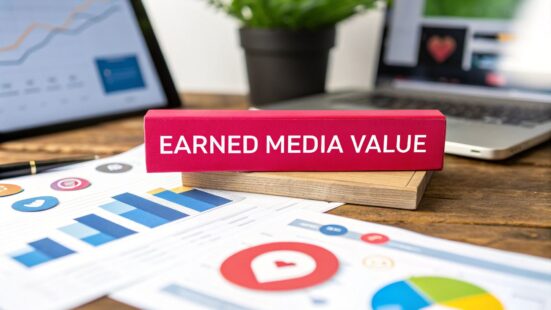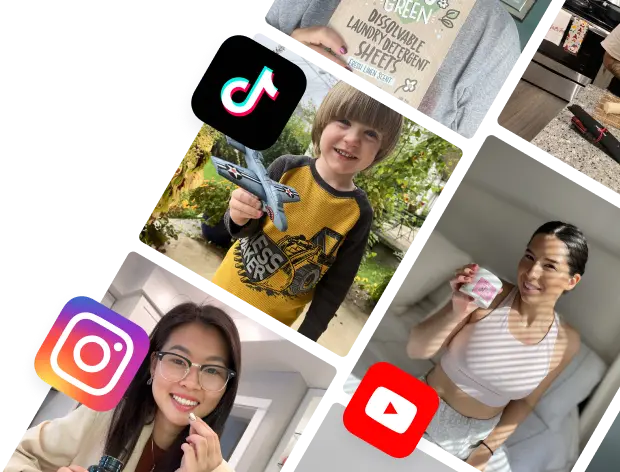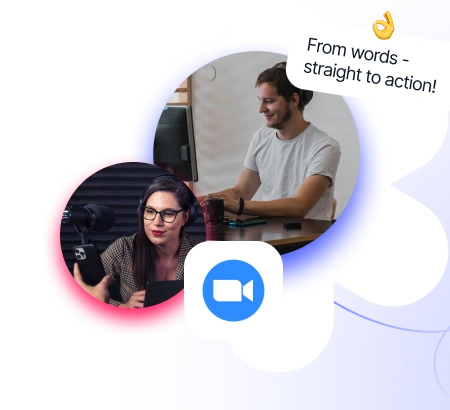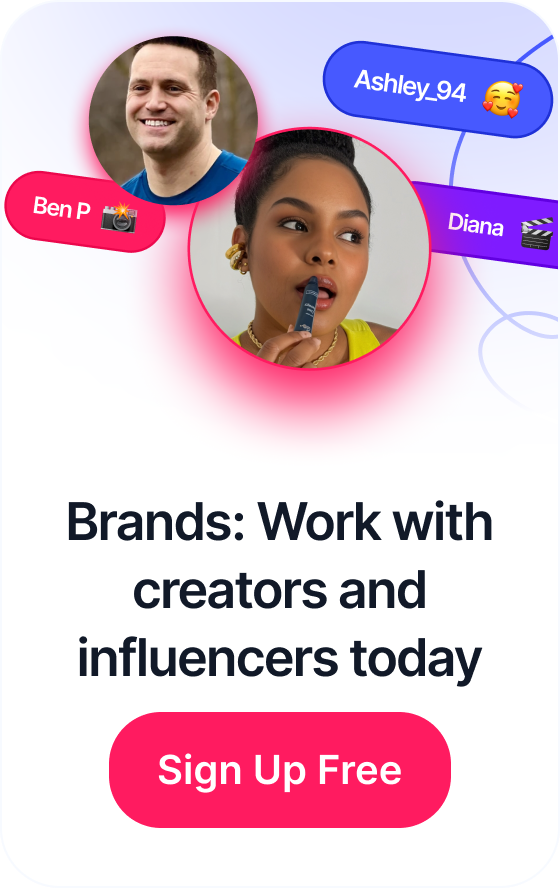 Influencer Marketing for Startups: Boost Your Brand Today
Influencer Marketing for Startups: Boost Your Brand Today
Earned Media Value (EMV) is a way to put a dollar figure on all the buzz your brand gets for free. Think of it as the 'street value' of your organic shoutouts—what you would have paid to get that same level of attention through good old-fashioned advertising. It helps quantify the worth of all those social media mentions, press features, and influencer posts you didn't have to pay for.
Table of Contents
What Is Earned Media Value and Why It Matters

Let's say your brand gets a mention in a viral TikTok video or a major news article pops up overnight—and you didn't spend a dime. That kind of exposure is gold, but how do you actually measure it? That's exactly where earned media value steps in.
EMV is the metric that turns organic attention into a number you can take to the bank. It gives marketers and executives a common language to talk about the real-world impact of their PR and creator marketing efforts.
Instead of just tallying up likes and shares, EMV puts a price tag on them using industry-standard ad rates. This turns abstract buzz into hard data, letting you stack your organic wins right up against your paid ad campaigns. It answers the big question: "How much would all this authentic, word-of-mouth promotion have cost if we’d had to buy it?"
The Importance of Credibility
The real magic of earned media is its credibility. People are tired of ads. They’re skeptical. A recommendation from a trusted influencer or a glowing review from another customer just hits different—it carries more weight than a sponsored post ever could.
This trust is what drives people to buy. Earned media feels genuine because it is genuine. It's a real endorsement, not a paid placement, and that authenticity is why it often drives way more engagement and builds stronger brand loyalty. EMV helps you measure the financial impact of that hard-won trust.
Earned media value bridges the gap between public relations efforts and business results. It provides a standardized metric to prove the financial contribution of campaigns that build brand reputation and audience trust, justifying marketing spend in a data-driven way.
Proving Campaign ROI
For any marketer, proving return on investment (ROI) is everything. Paid campaigns are easy—you have clear costs and conversion metrics. But the value of PR and organic social can feel a little… fuzzy. EMV cuts right through that fog.
By calculating the earned media value of a campaign, you can walk into a meeting and give stakeholders a clear, compelling number that proves its success. For example, if an influencer collaboration generated $50,000 in EMV, you can confidently report that your work secured fifty thousand dollars' worth of high-value exposure.
This is especially vital in the creator economy. With the global influencer marketing industry on track to hit $32.55 billion in 2025, it's clear brands are leaning heavily on creators. In fact, influencers are projected to generate around $236 billion in EMV in 2024 alone.
These numbers aren't just big; they show a massive shift in how brands build trust and expand their reach. You can discover more insights about earned media value on reach-influencers.com. This makes EMV an absolutely essential tool for measuring success in today's marketing world.
Owned, Paid, and Earned Media Explained

Before we can really sink our teeth into earned media value, we need to get a handle on where it fits in the bigger marketing picture. Most modern marketing strategies are built on three pillars: owned, paid, and earned media. They each have a different job to do, but the real magic happens when they all work together.
Let’s think about it like throwing a house party. Your success depends on how you handle these three elements.
H3: Owned Media: Your Digital Home
Owned media is everything you, well, own. It’s all the digital real estate you have total control over. Think of this as your actual house—your website, your blog, your email list, and your official social media profiles. You get to pick the music, the decor, and the guest list.
On these channels, you control the message completely. This is where you lay your brand’s foundation and tell your story exactly the way you want it told.
H3: Paid Media: Sending the Invitations
Paid media is just what it sounds like: you’re paying to get the word out and reach a bigger crowd. In our party analogy, this is like printing flyers, sending formal invitations, or running ads to let everyone know your party is the place to be.
You're paying for guaranteed placement and exposure, whether that's through social media ads, search engine marketing, or sponsored influencer posts. This is how you get new people—guests who've never even heard of you—to show up at your door.
H3: Earned Media: The Organic Buzz
And that brings us to earned media—the holy grail of marketing. Earned media is the organic chatter and word-of-mouth excitement your brand generates without you paying directly for it. It’s when people show up to your party simply because a friend told them it was awesome.
This is the kind of authentic, third-party validation that money just can't buy. It happens when a journalist covers your product, a customer leaves a fantastic review, or a creator gives you a shout-out just because they genuinely love what you're doing.
Earned media is the payoff for having a great product, top-notch service, and a compelling brand story. It’s the currency of trust, turning happy customers into a volunteer marketing army that shares your message with genuine credibility.
This kind of exposure carries the most weight because it comes from what feels like an unbiased source. In fact, 89% of people say they trust recommendations from people they know far more than they trust ads. That's precisely why calculating earned media value is so critical—it puts a number on the impact of this priceless organic promotion.
To make it even clearer, let's break down how these three media types stack up against each other.
H3: Comparing Owned, Paid, and Earned Media
Each media type brings something different to the table. Understanding their unique roles helps you build a more powerful and integrated marketing strategy.
| Media Type | Definition | Examples | Primary Benefit |
|---|---|---|---|
| Owned Media | Digital properties you have full control over. | Your website, blog, social media profiles, email newsletters. | Complete Control |
| Paid Media | Paying for ad placement to reach a new audience. | Google Ads, social media ads, paid influencer posts. | Immediate Reach |
| Earned Media | Organic exposure from third-party sources. | News articles, customer reviews, unpaid influencer mentions. | Authentic Trust |
As you can see, they all have their strengths. Owned media builds your foundation, paid media casts a wider net, and earned media generates the authentic buzz that builds true, lasting loyalty. A winning strategy uses owned and paid channels to spark the conversations that ultimately lead to that high-value earned media.
How To Calculate Your Earned Media Value
Trying to put a number on the "buzz" around your brand can feel like trying to catch smoke. But calculating your earned media value isn't as abstract as it sounds. It's really about taking all that organic chatter and translating it into a hard number that shows the real-world value of your PR and creator marketing efforts.
At its heart, the calculation is pretty simple. You track how your earned media is performing, figure out what you would have paid for that same exposure, and then add it all up.
This infographic breaks down the workflow, showing how you can go from tracking brand mentions to calculating a final EMV.

As you can see, the whole process starts with collecting the raw data—your mentions. From there, you figure out how many people it reached, and finally, you run the calculation to get your EMV. It's a clear path from data to dollar signs.
The Basic EMV Formula
The most common way to calculate earned media value boils down to a simple multiplication problem. You take your key performance metrics and multiply them by their equivalent advertising costs. While there are a few different ways to slice it, the core idea stays the same.
Here's the foundational formula:
- EMV = Impressions x CPM + Engagements x CPE
Let's quickly break down what those pieces mean:
- Impressions: The total number of times a piece of content, like a post from a creator, was shown to users.
- Engagements: All the interactions that happened on that content—think likes, comments, shares, and clicks.
- CPM (Cost Per Mille): The standard industry rate for what it costs to get one thousand impressions on a paid ad.
- CPE (Cost Per Engagement): The average cost you'd pay for a single engagement (like a click or a like) in a paid campaign.
This formula is great because it lets you assign a real dollar value to both eyeballs (impressions) and actions (engagements), giving you a much richer view of your media's true impact.
A Step-by-Step Calculation Guide
Calculating your EMV is a three-step dance: gather your data, find the right benchmarks, and then do the math. Let's walk through it.
1. Gather Your Performance Data
First things first, you need to round up all the relevant metrics from your earned media placements. This means every piece of user-generated content, every influencer mention, and any press features you've landed.
You'll need to track two key things:
- Total Impressions: How many eyeballs saw the content? Most social media platforms and analytics tools will give you this number.
- Total Engagements: Add up every single like, comment, share, and save. These are signals that people didn't just see your content—they connected with it.
For example, a solid user-generated content strategy will create a constant flow of posts from your community, and each one adds its own impressions and engagements to your overall total.
2. Source Your Industry Benchmarks
Next up, you need to find your advertising cost equivalents—the CPM and CPE values. These numbers are what make your EMV calculation accurate and meaningful. Don't just guess.
Here are a few places to find reliable benchmarks:
- Your Own Paid Campaigns: The best data is your own. Look at your past ad campaigns. What did you actually pay for impressions and engagements?
- Industry Reports: Marketing analytics firms often publish reports with average CPM and CPE rates for different industries and platforms.
- Platform Ad Managers: Tools like Meta Ads Manager can give you cost estimates for campaigns, which serve as a great reference.
Just remember, these rates are not one-size-fits-all. A CPM for a TikTok video in the beauty space is going to be wildly different from a LinkedIn article for a B2B tech company. Always aim to use benchmarks that are as close to your specific situation as possible.
3. Put It All Together with an Example
Okay, time to plug in the numbers. Let's say a beauty brand works with a creator who posts one Instagram Reel and one TikTok video.
Together, the content racks up 18,000 impressions and 500 engagements. After a bit of research, the brand finds its average ad costs are $20 CPM and $2 CPE.
Here's how the calculation shakes out:
- Impressions Value: (18,000 Impressions / 1,000) x $20 CPM = $360
- Engagements Value: 500 Engagements x $2 CPE = $1,000
- Total EMV: $360 + $1,000 = $1,360
In this scenario, the campaign generated $1,360 in earned media value. That's the amount the brand would have likely had to spend on paid ads to get the same results. While EMV gives you the equivalent ad spend, pairing it with a broader Return on Investment (ROI) calculation will give you an even fuller picture of your marketing's performance.
Strategies for Boosting Your EMV
Okay, so you're measuring your earned media value. That's a solid first step. But let's be real—the goal isn't just to measure it, it's to grow it.
Boosting your EMV is all about sparking more organic, high-value conversations around your brand. It’s the difference between passively watching your metrics and actively getting in the driver's seat. It's about making your brand so interesting that people genuinely want to talk about it.
This isn’t about chasing vanity metrics. We're talking about building an engine for authentic advocacy. The secret sauce is creating experiences and relationships so positive that creators, customers, and even the media feel an undeniable urge to share them. Let's dive into a few proven ways to make that happen.
Foster Authentic Creator Relationships
The most powerful earned media almost always comes from creators who feel like real partners, not just hired guns for a one-off campaign. Building genuine, long-term relationships is the absolute bedrock of boosting your EMV. Forget the single sponsored post and focus on building a community of advocates who are in it for the long haul.
This means you have to invest the time. Get to know their content, understand their audience, and see how your brand truly fits into their world. When a creator feels seen, valued, and aligned with your mission, they're far more likely to mention your products organically—even when the check has already cleared. Those unpaid shout-outs? That’s pure earned media gold.
A creator who loves your brand will become your most effective marketer. Their authentic enthusiasm is more credible and persuasive than any paid ad, generating high-quality earned media that resonates deeply with their followers.
Think about it this way: a skincare brand could send a personalized thank-you gift to a creator after a great campaign or give them an exclusive first look at a new product. These small gestures build serious loyalty and goodwill, which leads directly to the kind of spontaneous mentions that send your earned media value through the roof.
Design Share-Worthy Campaigns
If you want people to talk, you have to give them something remarkable to talk about. It’s that simple. Campaigns designed to be shared are a direct pipeline to a higher EMV. This means creating experiences, content, or products that are visually stunning, emotionally gripping, or just incredibly useful.
Put yourself in their shoes for a second. What makes you stop scrolling and smash that "share" button? It's usually content that is:
- Visually Striking: A beautifully designed product or an unforgettable unboxing experience is practically made for the ‘gram.
- Emotionally Engaging: Campaigns that tell a powerful story or tap into a shared human feeling can ignite widespread conversation.
- Exceptionally Helpful: A valuable how-to guide or an innovative tool that solves a real-world problem can spread like wildfire within its niche.
A big piece of this puzzle is following solid content marketing best practices. When your content is well-crafted from the start, it naturally encourages people to share it and start a discussion.
Implement Strategic Gifting and Affiliate Programs
Not every collaboration needs to be a massive, paid campaign. In fact, some of the most effective tactics for generating a steady drumbeat of earned media are strategic product gifting and well-structured affiliate programs.
Strategic Product Gifting isn't just about blindly mailing out products. It’s about sending your products to a carefully curated list of creators and influencers who already align with your brand—with no strings attached. While a post isn't guaranteed, an amazing product experience often leads to organic features, stories, and reviews. For a relatively low upfront cost, this method can deliver a huge return in EMV.
Affiliate Programs turn your biggest fans, from creators to your most loyal customers, into true brand ambassadors. By giving them a commission on sales they drive, you create a powerful incentive for them to talk about your products consistently. Every affiliate link shared on a blog, dropped in a YouTube description, or swiped up in an Instagram story is a piece of earned media that also drives direct revenue. It’s a powerful, self-sustaining marketing loop.
Looking at a range of successful influencer marketing campaign examples can give you some great ideas for crafting your own shareable initiatives.
How Public Relations Drives Earned Media Value

While creator marketing is a huge engine for earned media value today, the whole concept has deep roots in a classic discipline: Public Relations. At its heart, PR is the art of getting other people—credible, authoritative people—to talk about your brand in a positive light.
Think about it. A single, well-placed article in a respected online magazine or a feature on a top-rated podcast can set off a massive ripple effect. Unlike a paid ad that everyone knows is a sales pitch, this kind of coverage feels like an endorsement. It gives your brand a layer of trust and authority that you just can't buy.
From Storytelling to Media Placements
Good PR isn't about blasting out generic press releases and hoping for the best. It's about sharp, compelling storytelling. A skilled PR team finds what makes a brand's story genuinely newsworthy and then pitches that narrative to the right journalists, editors, and producers at the perfect time.
When a pitch finally lands, the resulting media placement is like a powerful megaphone. Suddenly, a publication's entire audience is introduced to your brand through a source they already trust. That alone generates a huge volume of high-quality impressions. Then, every time someone shares that article on social media, it creates even more value, pushing your reach far beyond the original readership.
This is big business. The public relations industry is on track to become a $112.98 billion global market by 2025. It's a tough game, though—only about 8% of pitches actually turn into a story. But that earned coverage is so valuable that nearly 60% of online businesses now outsource their digital PR. Want to dig deeper? You can explore more 2025 PR statistics on prlab.co.
Measuring the PR Impact with EMV
Before metrics like EMV came along, proving the ROI of public relations was a real headache. I mean, how do you slap a dollar value on a glowing feature in a major magazine? It was all gut feelings and vague estimates. Today, EMV gives us a clear answer.
By calculating the earned media value of these PR placements, teams can show real, tangible results. It’s no longer abstract. For example:
- A feature article: You can take the publication's reach (impressions) and compare it to its standard advertising rates to get a baseline EMV.
- A podcast interview: The number of listeners or downloads (impressions) can be valued against what it would cost to buy a sponsorship spot on a similar show.
- A product review: The credibility of the reviewer and the size of their outlet's audience all contribute to a calculable value.
Public Relations is the strategic foundation for earned media. It builds the credibility and narrative required to attract organic attention, turning compelling stories into measurable financial value through media placements and third-party endorsements.
This framework changes the conversation completely. It allows marketing leaders to see PR not as a cost center, but as a strategic investment that generates a measurable return.
It’s the same logic brands use when they learn how to pay influencers for their reach. EMV helps quantify the value of the reach you earn through smart PR, bridging the gap between old-school media relations and modern, data-driven marketing.
Common Misconceptions About EMV
While earned media value is a seriously handy metric, it gets misunderstood a lot. To really get the most out of it, you have to know what it's good for—and what it's not. If you treat EMV like some magic number that tells the whole story, you're setting yourself up for flawed strategies and missed opportunities.
One of the biggest mix-ups is thinking EMV is a direct line to sales or financial return. It’s not.
Think of it more like a brand awareness thermometer than a cash register. EMV is designed to tell you the equivalent ad cost for your organic exposure. That makes it a powerful stand-in for visibility, but it has no direct connection to your revenue. A high EMV means you’ve got a strong brand presence, but it definitely doesn't mean your sales shot up by that same dollar amount.
It's a Directional Tool, Not an Exact Science
Here’s another thing to get straight: EMV calculations are, by their very nature, estimates. The benchmarks they’re built on—like CPM and CPE—are just averages. And those averages can swing wildly depending on the industry, the platform, and even the time of year. Your actual costs for a paid campaign could easily be higher or lower.
Because of all that variability, earned media value is best used as a directional indicator. It’s absolutely perfect for things like:
- Comparing the relative success of different campaigns against each other over time.
- Tracking your brand’s visibility momentum—is your buzz growing or shrinking?
- Demonstrating the value of your PR and creator marketing efforts in a language that stakeholders can actually understand.
Think of EMV as a compass, not a GPS. It points you in the right direction and shows you're making progress, but it won't give you a precise, turn-by-turn financial map. It gives you vital context, but it needs to live within a larger analytics framework.
EMV Doesn't Understand Sentiment
Finally, a standard EMV formula has no idea if it's measuring a glowing review or a viral customer complaint. Zero clue.
It simply adds up the reach and engagement, completely blind to whether that attention is good or bad. A piece of negative content that gets thousands of shares will generate a sky-high EMV, but that "value" is obviously toxic for your brand.
This is exactly why you can't look at EMV in a vacuum. It absolutely has to be paired with sentiment analysis to give you the full, honest picture. When you combine these two, you stop asking "how much are people talking about us?" and start asking "how do they feel when they talk about us?" That critical context is what separates healthy brand buzz from a full-blown reputational crisis.
Got Questions About EMV? We've Got Answers.
Even after you get the hang of earned media value, a few questions always seem to pop up. It’s totally normal. Let's walk through the most common points of confusion so you can start using this metric like a pro.
Is Earned Media Value Just Another Name for ROI?
This is easily the number one question we hear, and the answer is a hard no. They measure two completely different, though related, things.
Think of it this way: EMV is like getting an appraisal on a house. It tells you the estimated market value of all your free publicity. ROI, on the other hand, is the actual profit you made after selling the house and paying all your expenses.
- EMV asks: "If we had to pay for all this organic buzz, what would the bill look like?"
- ROI asks: "For every dollar we actually spent on this campaign, how many dollars of profit did we get back?"
A sky-high EMV is a fantastic sign and often leads to great ROI, but they aren't the same number. EMV tracks the value of your visibility, not your direct financial return.
Where Can I Find Reliable Cost Benchmarks?
The whole point of an EMV calculation falls apart if you're just guessing at your cost benchmarks, like CPM (Cost Per Mille) and CPE (Cost Per Engagement). Pulling numbers out of thin air will throw your entire measurement off.
Here’s where to look for data you can trust:
- Your Own Ad Accounts: This is your best source. Dig into your past paid campaigns on platforms like Meta or Google. Your actual, historical CPM and CPE are the gold standard.
- Industry Reports: Big marketing analytics firms are always publishing reports on average ad costs. Look for ones that break it down by industry and platform.
- Platform Ad Planners: Most ad managers have built-in planning tools that give you cost estimates. These are perfect for getting a solid baseline for your calculations.
The secret is to get specific. A CPM for a TikTok video in the beauty space is going to be worlds apart from a LinkedIn ad for B2B software. For your EMV to mean anything, you have to use benchmarks that mirror your exact situation.
Can EMV Ever Be a Negative Number?
Technically, no. The standard EMV formula is blind to emotion—it only cares about the quantity of impressions and engagements. A disastrous piece of negative press that goes viral could, ironically, generate a massive and positive EMV number, even while it’s tanking your brand's reputation.
This is the biggest trap you can fall into if you only look at EMV. It can't tell the difference between a five-star review and a full-blown PR crisis.
That's why it's absolutely essential to pair EMV with sentiment analysis. This combo gives you the complete story, showing you both the size of the conversation and its overall tone.
Ready to stop guessing and start growing? JoinBrands connects you with over 250,000 creators to generate the authentic content and buzz that drives real earned media value. Find the perfect partners for your brand and manage your campaigns all in one place. Start your next high-impact campaign on joinbrands.com.








